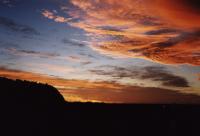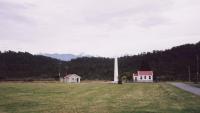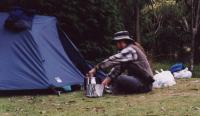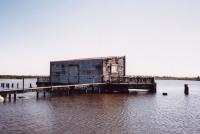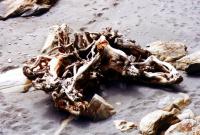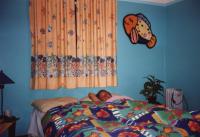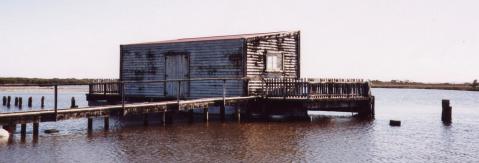
The old wharf at Okarito.
Click on a photograph to enlarge it. More photographs here
Travelogue 3, where we retire to Okarito for a little R&R.
hello beloveds,
yet time for another sharing. last time i had to stop rather abruptly because the internet cafe was closing.
after our last track we realize that surprisingly enough that the last week of february is already on and we should start to make our way up the westcoast towards Nelson. jalal has caught a bad cold so we drop our plan to do another alpine track as it is rated difficult und would take up another 5 days.
it is quite a way up to Nelson and we want to have a couple of stops for inland and coastal trekking. when the woman in the travel office asks where we want to get off the bus, jalal answers at Okarito. out on the street i inquire where is Okarito and jalal has no idea -- he heard about it somewhere and it is supposed to be really nice. so we rush into the next bookstore to browse through the travel guides (there is nothing in our book about it) and read: "Okarito is a small costal settlement with 20 inhabitants, no shops, no bank, a hostel with one double room and three singles and a very basic campside."
we better get our food supply stocked up before leaving, sounds like another adventure. the bus will drop us off the main highway and from there we have to hitch a ride down to the place (shouldn't be too difficult with approx. 15 cars going there and back -- argh!) otherwise we will walk the 13 km.
the bus ride takes us over the highest public road of nz (about 1200m)down to Wanaka, a delightful little village at the shores of Lake Wanaka and starting point of numerous tracks. Yet another lake to gaze at is the Lake Hawea, passing through Makarora and then over the Hast Pass into the town of Haast. the haast pass has only been completed in 1965 - until then there was no connection from the southern part of the South Island (Fjordlands and Southern Alps) to the whole west coast area. you had to go all the way back up to Christchurch and then cross Arthur's Pass to reach there.
From Hast we drive on long windy mountain roads (i'm getting pretty dizzy after 3 hours) until we reach Fox Glacier and shortafter Franz Josef (jawoll!) Glacier (more touristy places with guided tours and helicopter rides..)- too busy for us. i am anyway not so hot on glacier walks. :)
half an hour later the bus stops and we get off right in the middle of nowhere, facing a signpost saying Okarito 13km. the moment i am about to pick up my pack, a car drives by and instinctively put up my thumb and it is a lady on her way home to Okarito. there we go, jumping in her car and chatting away. within 20 minutes we arrive in the only street there. it is stunningly beautiful - this little hamlet right on the shores of Tasman Sea.
formerly it had been a booming goldmining town with a population of over 1200 and another 2500 in the area during the heights of the gold rush in 1866 (a bit of historical info won't hurt ;)
today Okarito area features with its exquisite natural lagoon caters for over 4000 birds. more than 76 species have been recorded to live in the area. over 3000 hektar makes it the biggest wetland on the westcoast and the main feeding ground for white herons (kotuku - sacred bird for the maori people) and royal spoonbills. the white herons breed north of the lagoon in a nature reserve where access is only by permit of the DOC.
hidden away in the depth of the Okarito rainforest
lives a small kiwi population - the Okarito Brown
Kiwi.
the kiwi, the national bird of nz is slowly
diminishing from the planet mainly due to its
predators like the possums (public enemy no1 and a
plague). this is a furry little animal on four legs,
which was introduced for the furtrade and quickly got
out of hand as there are no predators, means nobody
eats them as they about as wild as it gets in nz.
a lot of birds actually have forgotten how to fly
through their evolution, even though they still have
their wings, but there was no need to fly - so they
happily hopped around on the ground. nowadays that
makes them an easy target for the possums, who eat the
eggs or the stoats, who eat the chicks or the rats,
who eat whatever they get. 95% of the kiwi die before
they reach one year of age. the kiwi population is
closely surveyed by the DOC's Kiwi Recovery Program.
right in birdwatcher paradise, pitch our
tent on the "basic campsite" and take a stroll at the
beach to watch a dramatic display of thousand shades
of red for the sunset.
the next day we track to the Okarito Trip Point from where we get a view of the Southern Alps and Mt.Cook. we move further inland through wonderful Rimu trees and lush ferns to the Three Mile Lagoon. on the return we take a coastal path along the beach. it is a glorious sunny day and i walk on the cleanest beach i have ever seen. not a plastic bottle in sight, no tar, no algae, no old tyres -- just water, sand, pebbles -- it feels utterly pristine - without trace of mankind!
we rest on a huge sofashaped rock just to enjoy the whole scenery, crafted by nature. i am afraid i am getting quite poetic about it :)
the only shop in Okarito is the nature tours shop - a kayak rental place, run by a nice young couple and their dog. next day we rent a kayak to explore the lagoon and all its hidden channels, fed by natural rivers. we get out at eight o'clock to catch all the early birds out for breakfast. armed with our birdbook, binoculars, camera and a nice picnicbag we paddle off in our little double seater. it is a wonderful experience to glide soundlessly through the waters, listening to all the birdsongs (bellbirds, fantails, fernbird and much more), seing all the plants - pure meditation.
we are out all day - i am turning into kayak woman - watching white herons, ducks, whitefaced herons - not so many wading birds as the lagoon is blocked and the waterlevel is higher than usual - but still we find some funny oystercatchers. luckily it is a cloudy day, otherwise i think by now we would have turned into fried chicken on the water. we return late afternoon, after a little picnic on a shore and have a warming cup of tea and a chat with the people from the place. we arrange with a friend of theirs to bring us up the road the next day -- as we arranged a pick up by the bus to Greymouth, our next station.
back in the so called civilised world we check in a superfunny backpackers called Neptunes and the entire theme of the house, meaning all rooms, bathrooms, toilets etc. is underwater world - it feels like living in a very colorful aquarium. we hang around town, go out for dinner, stock up on our supplies as we are planning to go on to Punakaiki to do a 2/3 day inland trail through limestone gorges and rivers. also we will see famous pancake rocks and the blowholes --huii!
i hope there will be lots more to tell you soon. i feel very blessed that i can share all this beauty with you - thank you for being such wonderful friends!
until later all our love ajara and jalal
ps: edits for travellog2: whereever i wrote birch trees or forest it should of course say beech trees or forest.
Contact: treks@gnomedia.com
